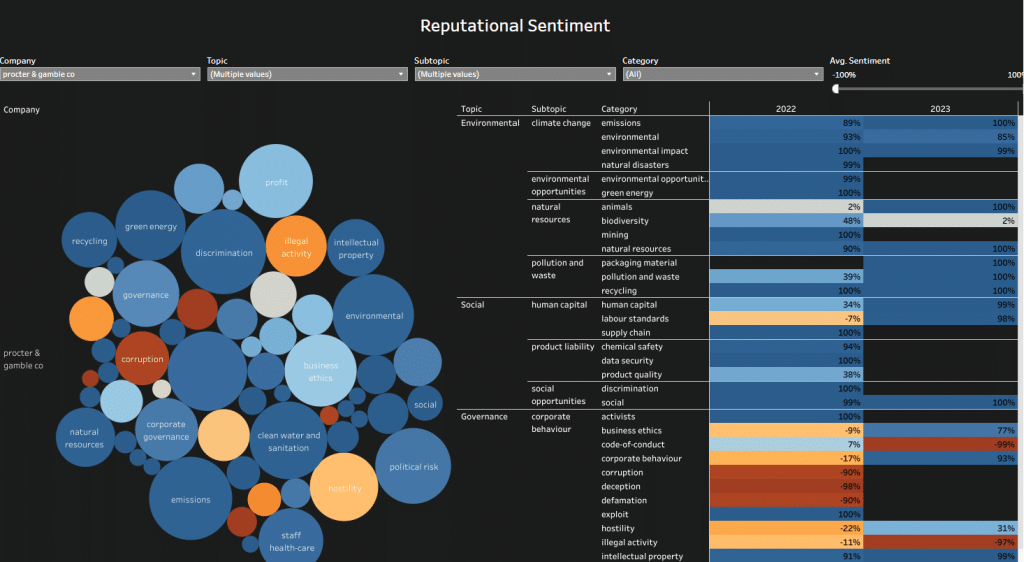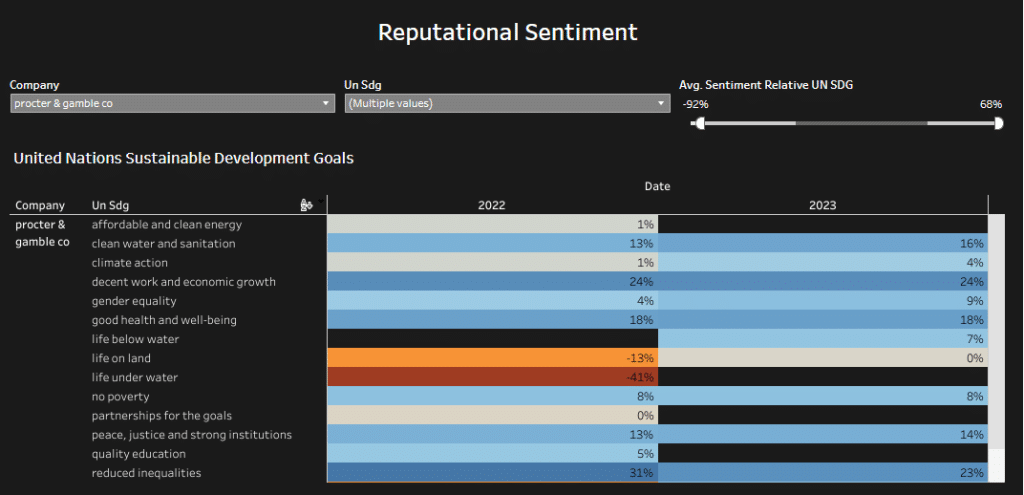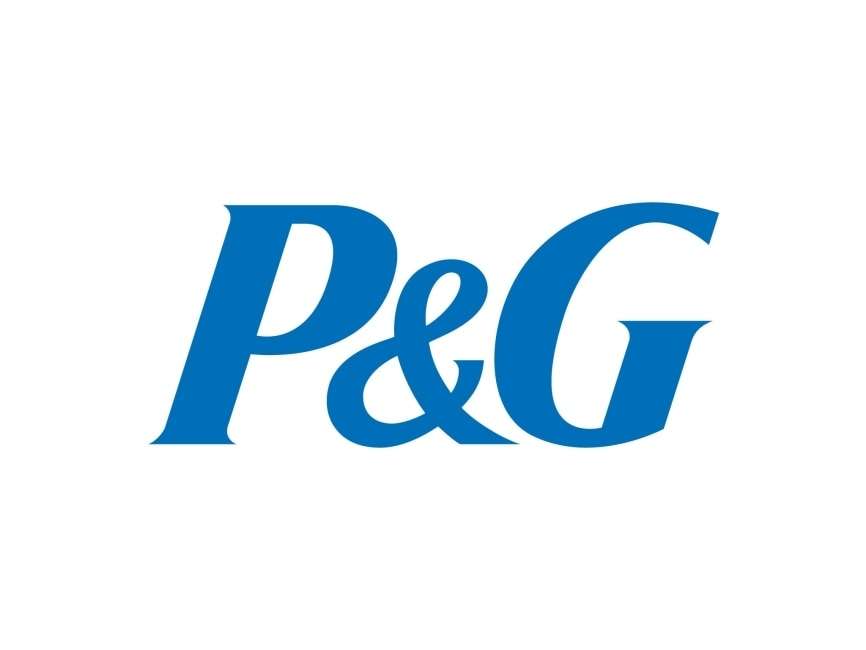Proctor & Gamble (P&G), the multinational consumer goods corporation headquartered in Cincinnati, Ohio, has a rich history dating back to 1837, and has grown to become one of the world’s largest and most well-known companies, offering a wide range of products including household cleaning supplies, personal care items, and baby care products. P&G’s commitment to innovation, quality, and sustainability has positioned them as a leader in the industry. In this article we’ll take a deep dive into our Proctor & Gamble ESG score according to our latest data.
What is ESG and why is it important?
ESG stands for Environmental, Social, and Governance, and it refers to the three main factors used to measure the sustainability and ethical impact of a company’s operations. Environmental factors include a company’s impact on the environment, such as carbon emissions and waste management. Social factors encompass a company’s relationship with its employees, customers, and communities. Governance factors focus on a company’s internal policies and practices, including diversity and transparency. ESG has gained significant importance in recent years as consumers and investors increasingly prioritize sustainability and ethical practices.
Overview of the Proctor & Gamble ESG score
According to our data at time of writing, the Proctor & Gamble ESG score comes in at 88 for environmental factors, 91 for social factors and 54 for governance factors. What instantly stands out if that their social score is higher than there environmental score, which is uncommon across most of our company data. But why is this?
Proctor & Gamble’s social score is likely higher than its environmental score due to its long-standing commitment to social responsibility, transparent approach, and accountability to stakeholders. The company’s social initiatives have led to a strong track record of positive outcomes, including diversity, inclusion, philanthropy, employee engagement, and workplace safety.
Despite progress in some environmental areas, Proctor & Gamble’s use of palm oil and synthetic chemicals has attracted criticism for potential environmental and human health impacts. The company needs to continue making strides in environmental sustainability to elevate its overall score. We will take a closer look at all these aspects below.

P&G’s commitment to sustainability and ESG initiatives
P&G has long recognized the importance of sustainability and has made a firm commitment to integrate ESG principles into its business practices. The company’s sustainability vision, known as “Ambition 2030,” sets ambitious goals to address some of the world’s most pressing challenges, including climate change, water scarcity, and waste reduction. P&G aims to achieve zero manufacturing waste to landfill, use 100% renewable or recycled materials in all products and packaging, and reduce greenhouse gas emissions across its value chain.
Overview of P&G’s environmental initiatives
P&G has implemented a variety of environmental initiatives to reduce its impact on the planet. One of the key areas of focus is renewable energy. The company has committed to powering its plants with 100% renewable electricity by 2030. P&G is also investing in renewable energy projects and exploring innovative technologies to further reduce its carbon footprint. Additionally, P&G has set a goal to reduce water consumption by 35% per unit of production by 2030, and has implemented water conservation measures across its operations.
Another important aspect of P&G’s environmental initiatives is waste reduction. The company aims to achieve zero manufacturing waste to landfill by 2030. P&G has implemented waste reduction programs, such as recycling and composting, in its manufacturing facilities. The company is also working towards using 100% recyclable or reusable packaging for all its products by 2030. These initiatives not only contribute to a more sustainable future but also help P&G reduce costs and improve operational efficiency.
P&G’s social responsibility efforts
In addition to its environmental initiatives, P&G places a strong emphasis on social responsibility. The company is committed to promoting diversity and inclusion, both within its workforce and in the communities it operates in. P&G has set a goal to achieve gender equality in its management positions and to ensure that women hold at least 50% of all entry-level positions. The company also supports various initiatives to empower women and girls, including education programs and economic empowerment projects.
Furthermore, P&G is dedicated to making a positive impact on the communities it serves. The company has a long history of philanthropy and has contributed significant resources to address societal issues. P&G has launched numerous initiatives to improve access to clean drinking water, provide disaster relief, and support education and healthcare programs in underserved communities. By actively engaging in social responsibility efforts, P&G is not only making a difference in the lives of individuals but also strengthening its brand and reputation.
Proctor & Gamble governance score
While Proctor & Gamble has a strong commitment to corporate governance, the company’s governance score of 54 out of 100 indicates room for improvement. Factors influencing this score include board composition, executive compensation, shareholder rights, and transparency and disclosure.
P&G’s board is majority independent, a positive aspect, but could benefit from enhanced diversity in terms of gender, ethnicity, and experience. Executive compensation is linked to performance, a commendable practice, but CEO pay could be revisited to mitigate excessive compensation risks. Strengthening shareholder rights by embracing proxy access, enabling shareholder nominations for board members, would further empower stakeholders.
P&G generally demonstrates transparency in governance practices and publishes an annual corporate governance report. However, providing more detailed insights into boardroom dynamics and risk management approaches would strengthen transparency. By addressing these areas, P&G can elevate its governance score and overall ESG performance.


Procter & Gamble ESG score and recognition
P&G’s commitment to sustainability and ESG practices has been widely recognized and acknowledged. The company has consistently received high rankings in various sustainability and ESG assessments. For instance, P&G has been included in the Dow Jones Sustainability Index for many years, which recognizes the top sustainability performers globally. P&G has also received recognition for its efforts in climate change mitigation, water stewardship, and responsible sourcing. These rankings and accolades validate P&G’s dedication to sustainable business practices and serve as a testament to its leadership in the industry.
The benefits of sustainable business practices for P&G
Implementing sustainable business practices brings numerous benefits to P&G. Firstly, it helps the company reduce its environmental impact and conserve natural resources, which contributes to a healthier planet. By using renewable energy and reducing waste, P&G can lower its carbon emissions and minimize its ecological footprint. These efforts not only align with consumer expectations but also position P&G as an industry leader committed to environmental stewardship.
Secondly, sustainable practices can drive innovation and improve operational efficiency. P&G’s focus on renewable materials and packaging innovation has led to the development of more sustainable products, which resonate with environmentally conscious consumers. Additionally, waste reduction initiatives and energy-saving measures can result in cost savings and improved resource allocation. By integrating sustainability into its business model, P&G can create value for both the company and its stakeholders.
Lastly, sustainable business practices enhance P&G’s reputation and brand image. In today’s socially conscious world, consumers are increasingly drawn towards companies that demonstrate a genuine commitment to sustainability and ethical practices. By showcasing its ESG initiatives and transparently communicating its progress, P&G can build trust and loyalty with its customers. This ultimately translates into increased market share, customer satisfaction, and long-term business success.
Challenges and obstacles faced by P&G in implementing ESG initiatives
While P&G has made significant progress in its sustainability journey, it has also encountered challenges and obstacles along the way. One of the main challenges is the complexity of global supply chains. P&G sources materials and components from numerous suppliers worldwide, making it challenging to ensure sustainable practices throughout the entire value chain. Collaborating with suppliers, setting clear expectations, and providing support and resources are essential to overcome this challenge.
Another obstacle is the need for continuous innovation and research. Developing sustainable products and materials requires ongoing investment in research and development. P&G must stay at the forefront of technological advancements and collaborate with experts and partners to find innovative solutions. This can be resource-intensive and time-consuming, but it is crucial for P&G to maintain its competitive edge and deliver on its sustainability commitments.
Furthermore, P&G faces the challenge of balancing sustainability with cost-effectiveness. While sustainable practices often lead to long-term cost savings, there may be upfront investments required for infrastructure upgrades, technology adoption, and employee training. P&G must carefully evaluate the financial implications of its sustainability initiatives and ensure that they align with its long-term business strategy.
Proctor & Gamble ESG score peer comparison
P&G in the top 13% of companies for its ESG practices. However the P&G ESG score is lower than some of its competitors, such as Unilever, Colgate-Palmolive, and Nestlé. However, P&G’s score is still above average for the consumer packaged goods (CPG) industry. P&G’s primary areas of weakness are its environmental performance, particularly its use of palm oil and synthetic chemicals, and its governance performance, particularly its handling of tax issues.
Take a look at P&G’s competitor ESG scores below:
- Unilever ESG score
- The Clorox Company ESG score
- Johnson & Johnson ESG score
- Colgate-Palmolive ESG score
- Kimberly-Clark ESG score
- Henkel ESG ESG score
- Estee Lauder companies ESG score
- Reckitt Benckiser ESG score
Proctor & Gamble ESG score: final thoughts
In conclusion, Proctor & Gamble’s commitment to sustainability and ESG initiatives sets a positive example for the business world. Through its environmental initiatives, social responsibility efforts, and governance practices, P&G is driving positive change and making a significant impact on the planet and society. By integrating sustainability into its business model, P&G not only reduces its environmental footprint but also strengthens its brand, improves operational efficiency, and enhances its reputation. As P&G continues to set ambitious goals and pursue innovative solutions, it paves the way for a more sustainable future and inspires other companies to follow suit. Embracing ESG principles is not only the responsible thing to do but also a strategic advantage in today’s rapidly changing world.
Find out more
Ready to dive deeper into Procter & Gamble’s ESG score? Unlock more granular insights and detailed data by filling in the form below. Stay informed and join us in the journey towards a sustainable future.
